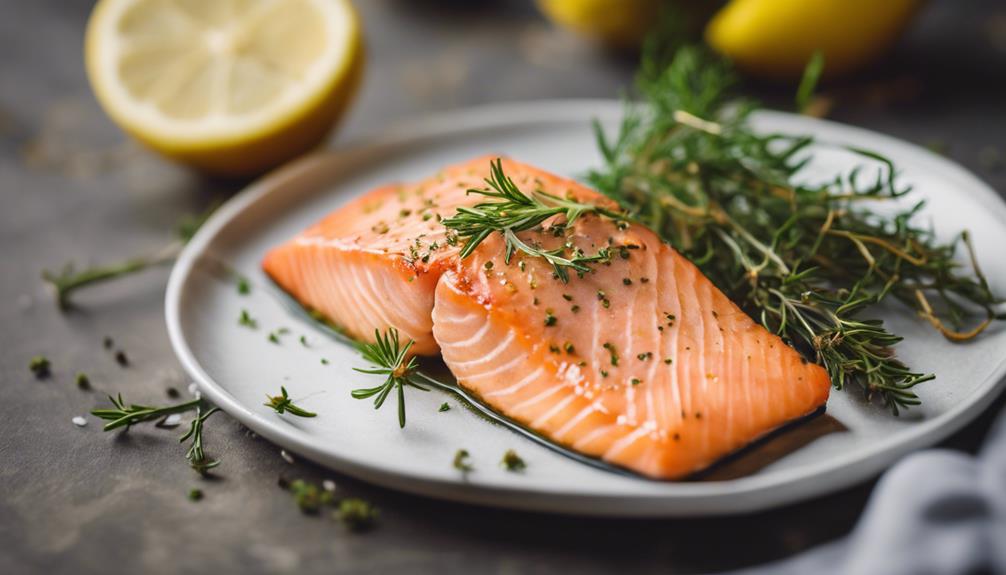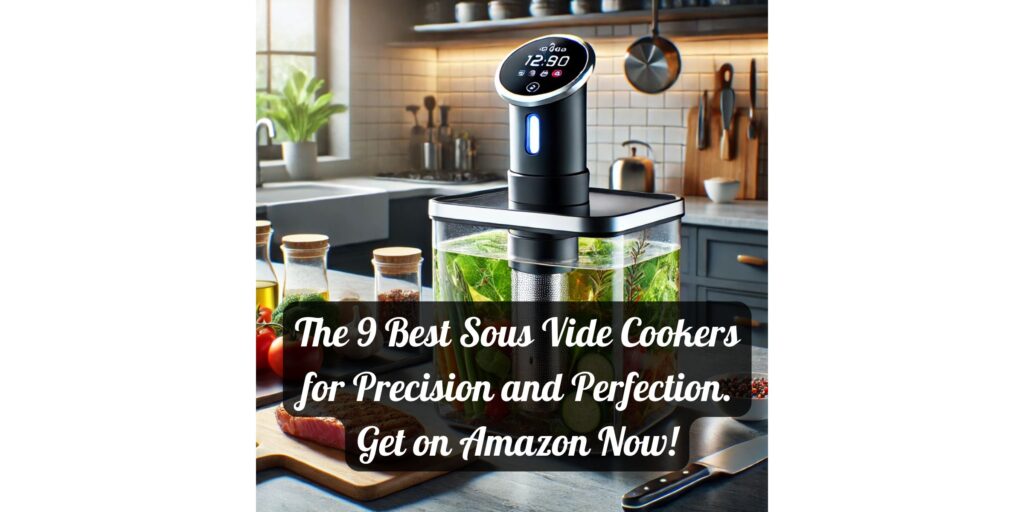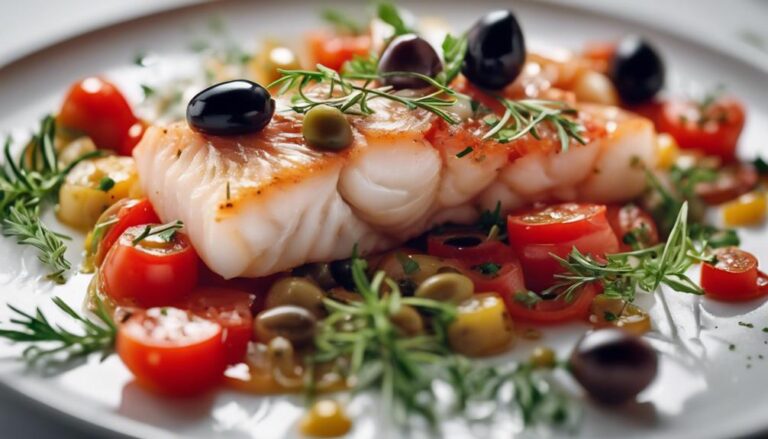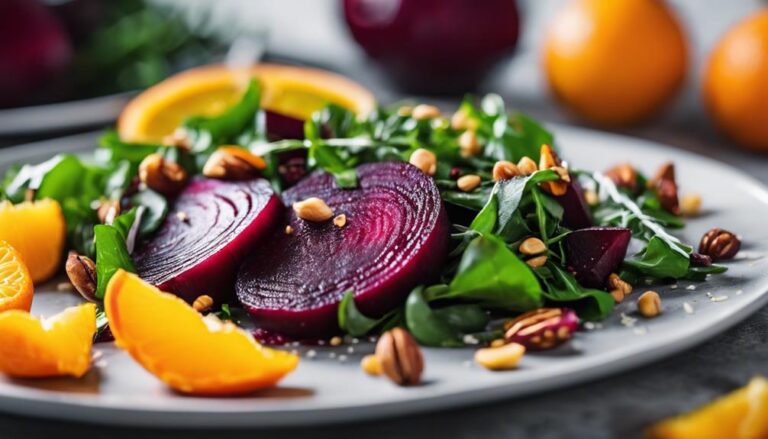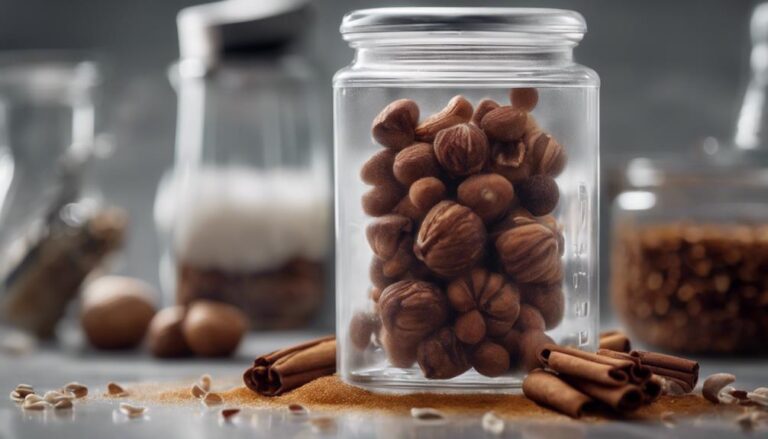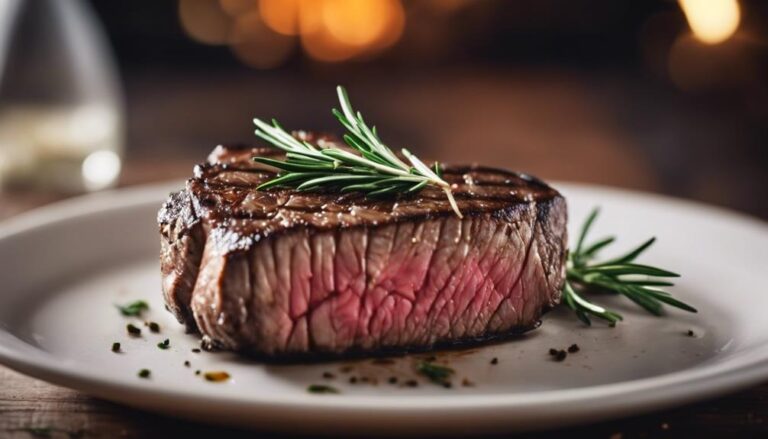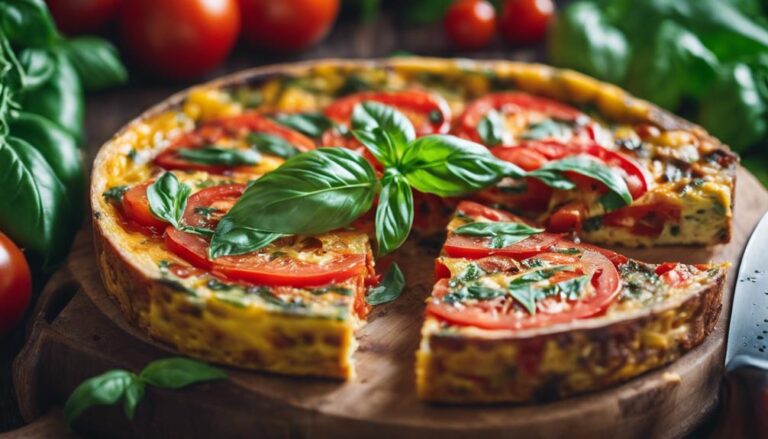Sous Vide Lemon-Thyme Salmon Fillets
For succulent sous vide lemon-thyme salmon fillets, seal seasoned fillets in a bag and cook them in a water bath for an hour. Massage the ingredients post-cooking and add a flavorful sauce. Seared skin-side down enhances texture. Garnish with fresh herbs and drizzle a lemony butter sauce over the fillets. Precisely controlled cooking temperatures give varying textures. Enjoy the burst of citrusy herb flavors in this tender salmon dish. [Further details on seasoning variations, finishing techniques, and recipe benefits await your culinary exploration.]
What You Will Learn Here
- Sous vide technique ensures precise cooking of lemon-thyme salmon fillets.
- Lemon-thyme infusion enhances flavor profile of salmon.
- Vacuum sealing preserves moisture and flavors in salmon fillets.
- Cooking in water bath guarantees even cooking of salmon.
- Lemon-thyme salmon fillets offer a delightful and tender dining experience.
Origin of Sous Vide
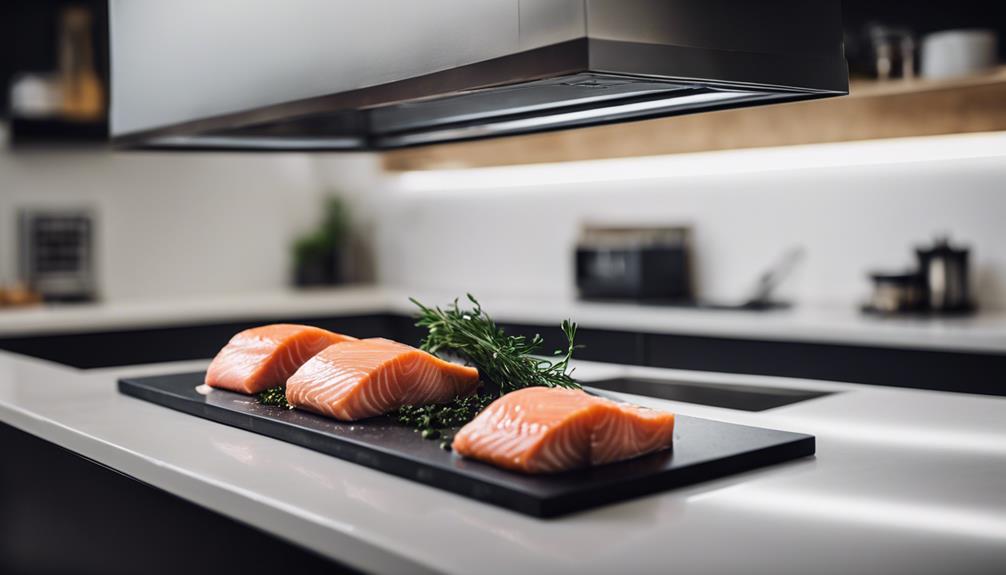
Sous vide cooking, originating in France, involves vacuum-sealing food before cooking to achieve precise results. Developed in the 1970s by French and American chefs, this technique allows for proteins to be cooked to specific temperatures consistently.
Sous vide has evolved into a modern cooking method popular for its ability to retain moisture and flavors, making it a convenient choice for home cooks seeking restaurant-quality dishes.
Sous Vide History
Originating in France in the 1970s, the cooking technique known as sous vide was pioneered by chefs Georges Pralus and Bruno Goussault, revolutionizing culinary precision through vacuum-sealed cooking methods. The term 'sous vide' translates to 'under vacuum' in French, highlighting the method of cooking food in a vacuum-sealed bag. This technique allows for precise temperature control in a water bath, ensuring even cooking while retaining moisture and flavor. Sous vide cooking gained popularity due to its ability to deliver consistent and repeatable results, making it a favorite in both professional kitchens and home cooking. This method excels in producing tender, flavorful dishes across a wide range of foods, from meats to vegetables and even desserts.
| Sous Vide History | |
|---|---|
| Origin: | France |
| Pioneers: | Georges Pralus, Bruno Goussault |
| Translates to: | 'Under vacuum' |
Sous Vide Technique
France, where the sous vide technique originated in the 1970s, introduced a culinary innovation that revolutionized precision cooking methods. Sous vide, meaning 'under vacuum,' involves cooking food in vacuum-sealed bags immersed in a water bath at controlled temperatures. This method guarantees consistent and precise cooking results by maintaining a constant temperature throughout the process.
Sous vide cooking commonly utilizes immersion circulators or sous vide sticks to regulate water temperature accurately. This technique is renowned for producing moist, tender, and evenly cooked dishes, ranging from meats and fish to vegetables and custards. By allowing the infusion of flavors, marinades, and aromatics into the food during cooking, sous vide enhances the taste and texture of various dishes, making it a versatile and popular method in modern cuisine.
Modern Sous Vide
The inception of modern sous vide technique in culinary history marked a significant evolution in precision cooking methodologies. Sous vide, meaning 'under vacuum' in French, involves vacuum-sealing food in a bag and cooking it in a water bath at a precise temperature. This method, originating in the 1960s in France, guarantees even cooking and flavorful results, particularly popular for cooking Sous-Vide Salmon, meats, fish, vegetables, and desserts like custards and cheesecakes. The table below highlights key aspects of modern sous vide cooking:
| Key Aspects | Description |
|---|---|
| Origin | 1960s in France |
| Meaning | 'Under vacuum' in French |
| Cooking Process | Vacuum-sealing food and cooking in a precise water bath at a set temperature |
| Popular Dishes | Meats, fish, vegetables, desserts like custards and cheesecakes |
| Benefits | Guarantees even cooking and flavorful results |
Salmon Seasoning Variations

For a dynamic flavor profile in your sous vide lemon-thyme salmon fillets, consider incorporating herbs like dill or parsley into your seasoning blend. These herbs can complement the citrusy notes of the lemon and thyme, adding layers of freshness to your dish.
To elevate your salmon seasoning, experiment with the following variations:
- Lemon Zest and Lemon Juice: Enhance the citrusy essence by incorporating both lemon zest and lemon juice into your seasoning mix. The zest provides a burst of flavor, while the juice adds a tangy brightness.
- Garlic and Black Pepper: Introduce a savory depth by including minced garlic and a sprinkle of freshly ground black pepper. These ingredients can enhance the overall aroma and taste of the salmon.
- Chili Flakes and Paprika: For a hint of heat and smokiness, blend in some chili flakes and a touch of paprika. This combination can add a subtle kick to your salmon fillets.
- Soy Sauce and Ginger: Create an Asian-inspired twist by marinating your salmon in a mixture of soy sauce and grated ginger. The umami from the soy sauce and the zing from the ginger can offer a unique flavor profile to your dish.
Sous Vide Salmon Variations
When exploring sous vide salmon variations, you can create delicious Lemon-Thyme Salmon Sous-Vide, experiment with Sous-Vide Salmon With Citrus, or try making Sous-Vide Salmon Skewers.
These variations allow for a range of flavor profiles and presentations that cater to different tastes and preferences.
Delicious Lemon-Thyme Salmon Sous-Vide
Enhance your salmon fillets with an invigorating lemon-thyme infusion using the sous-vide cooking method for peak flavor retention.
- Seal in Flavor: Utilize a vacuum sealer to lock in the freshness and juices of the salmon, ensuring a succulent outcome.
- Moisture Preservation: Sous-vide cooking maintains the natural moisture of the salmon, resulting in a tender and juicy texture.
- Precise Cooking: By cooking at precise temperatures, you can achieve perfectly cooked salmon that flakes delicately with each bite.
- Aromatic Combination: The blend of lemon and thyme creates an invigorating and aromatic profile, enhancing the inherent taste of the salmon fillets.
Savor the delectable flavors and tender texture of lemon-thyme salmon, prepared to perfection through the sous-vide method.
Sous-Vide Salmon With Citrus
Utilize the sous-vide cooking technique to infuse your salmon with vibrant citrus flavors, ensuring ideal and moist results every time.
- Select your favorite citrus fruits such as lemon, lime, or orange to add a zesty kick to your salmon.
- Place your seasoned salmon fillets and citrus slices in a vacuum-sealed bag to marinate flavors thoroughly.
- Use a vacuum sealer to remove air from the bag, ensuring perfect contact between the citrus and salmon.
- Set your sous-vide machine to the desired temperature and let the salmon cook gently in the citrus-infused bath.
Sous-Vide Salmon Skewers
For precise and flavorful results, consider preparing Sous-Vide Salmon Skewers infused with the delicate flavors of lemon and thyme. To achieve this, follow these steps:
- Prepare the Salmon: Season salmon fillets with salt, pepper, lemon zest, and fresh thyme.
- Skewer the Fillets: Thread the seasoned salmon onto skewers, guaranteeing even distribution.
- Vacuum Seal: Place the skewers in a vacuum-sealer bag, eliminating air to guarantee proper cooking.
- Sous Vide Cooking: Cook the salmon skewers in a water bath at 125°F (52°C) for 30 minutes to achieve a moist and flavorful result.
Sous Vide Finishing Techniques
When finishing your sous vide salmon fillets, you aim to apply flavorful touches, enhance presentation, and improve texture.
Searing the salmon in a hot pan with oil can create a crispy exterior and elevate the overall taste.
Experimenting with different techniques allows you to find the ideal balance for a visually appealing and delicious dish.
Flavorful Finishing Touches
Enhance the flavor profile of your sous vide salmon fillets by applying a vibrant lemon-thyme butter sauce as a finishing touch.
To prepare the sauce, vacuum seal butter, lemon zest, lemon juice, and fresh thyme in a bag and cook sous vide at 140°F for 1 hour. Once done, remove the bag and gently massage the ingredients to combine.
Cut a corner of the bag and drizzle the fragrant sauce generously over the perfectly cooked salmon fillets. The lemon and thyme infusion will add a burst of citrus and herb flavors, elevating the taste and presentation of your dish.
This flavorful finishing touch complements the delicate flavor of the salmon, creating a harmonious culinary experience for your guests.
Presentation and Plating
After perfectly cooking your salmon fillets sous vide, consider enhancing their visual appeal by searing the skin-side down for added texture and presentation. The crispy skin not only provides a delightful contrast but also elevates the overall aesthetic of the dish.
Before plating, garnish with fresh herbs like thyme or parsley to introduce a burst of color and flavor. Using a vacuum sealer can help maintain the integrity of the fillets during the finishing process.
Drizzle a lemon butter sauce or a light vinaigrette over the salmon to amplify its taste profile. When plating, be creative and experiment with different styles to craft a visually pleasing presentation that will impress your guests.
Textural Enhancements
For precise textural enhancements in salmon fillets using sous vide finishing techniques, meticulous control over cooking temperatures is essential to achieve desired tenderness and juiciness. To guarantee the perfect texture, it's vital to seal the bag properly, removing as much air as possible to promote even cooking. Here's a table outlining different sous vide finishing techniques for salmon fillets:
| Sous Vide Technique | Description | Result |
|---|---|---|
| Low Temperature (110°F) | Delivers a buttery-soft texture | Very tender and delicate |
| Medium Temperature (130°F) | Achieves a flaky-yet-moist consistency | Moist and flaky texture |
| High Temperature (140°F) | Yields a firmer, meatier texture | Robust and juicy |
Final Thoughts
In conclusion, the overall appeal of Sous Vide Lemon-Thyme Salmon Fillets lies in its impeccable fusion of flavors and consistently tender texture.
The use of a vacuum sealer guarantees that the salmon is infused with the aromatic blend of lemon and thyme, enhancing its natural taste.
By cooking the salmon sous vide, you can precisely control the cooking temperature, resulting in a perfectly moist and flavorful dish every time.
The simplicity of this recipe makes it an ideal choice for those looking to enjoy a delicious salmon meal with minimal effort.
The sous vide method ensures that the salmon fillets are cooked to perfection, maintaining their delicate texture and ensuring a delightful dining experience.
Whether you're a cooking enthusiast or someone looking for a hassle-free way to prepare salmon, Sous Vide Lemon-Thyme Salmon Fillets offer a delectable option that's sure to impress your taste buds.
Frequently Asked Questions
What Is the Best Sous Vide Temp for Salmon?
For best results, set your sous vide temperature between 110°F and 130°F when cooking salmon. Lower temps around 110-120°F yield a tender, buttery texture, while 125-130°F gives a firmer, flakier outcome. Sous Vide Techniques guarantee precise cooking.
Can You Sous Vide Salmon Too Long?
You can indeed sous vide salmon for too long, leading to undesirable textures. Sous vide overcooking can result in overly soft or mushy salmon. It's important to monitor cooking times and temperatures to achieve ideal texture and flavor.
What Temperature Should Fish Fillet Be Sous Vide?
For Sous Vide Halibut, guarantee ideal texture and doneness by setting the temperature within the range of 105°F to 130°F. Maintain precise control to achieve perfectly cooked fillets. Adjust temperatures for different fish types.
Do You Need to Brine Salmon Before Sous Vide?
You should brine salmon before sous vide cooking for enhanced flavor, texture, and moisture retention. Brining benefits include improved taste and tenderness. Sprinkle salt on the salmon, allowing it to rest before cooking for a juicy dish.
Conclusion
Once your salmon fillets are cooked to perfection using the sous vide method, the possibilities for finishing techniques are endless.
Whether you choose to sear them in a hot skillet for a crispy skin or torch them for a smoky flavor, the results will be moist, tender, and flavorful.
Experiment with different seasonings and garnishes to create your own unique twist on this classic dish.
Enjoy your perfectly cooked sous vide lemon-thyme salmon fillets!
